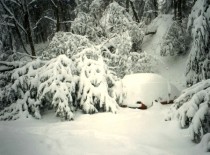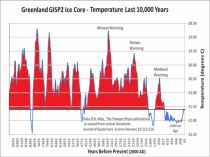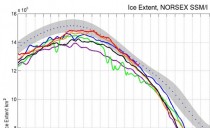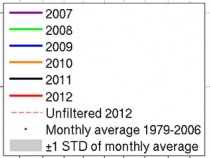Winter Hits Europe - Stockholm Has Coldest Day in 84 Years! Sweden Coldest Temperature In 20 Years!
By P Gosselin on 3. Juni 2012
Parts of Europe are being gripped by unusual cold, even though the calendar says it’s meteorological summer. Now children in Sweden are finding out what snow is like - in June! Strangest warming I’ve ever seen.
Winter pounds Sweden - and it’s summer!
The English language The Local here writes that “Stockholm broke an 84-year-old cold record on Saturday, as the capital’s temperature only reached 6 degrees Celsius, the lowest June maximum daily temperature the city has seen since 1928.”
Indeed, you could be excused for thinking that the current chill is more like winter than summer. It was actually colder in the capital yesterday than on Christmas Eve. ‘The temperature was a degree lower than it was at Christmas in Stockholm, so it is colder. And it’s windier, too,’ said SMHI’s meteorologist Lisa Frost to newspaper Dagens Nyheter.”
Just two days ago The Local here reported that snow blanketed northern parts. Residents in northern Sweden were forced to grab shovels rather than sun lotion on what was supposed to be the first day of summer, as much of the region was left covered in a thick blanket of snow on Friday. As much as 20 centimetres of thick, wet snow fell in parts of Västerbotten County, giving residents quite a shock when they woke up Friday morning.”

The mercury also dropped to minus 6 degrees Celsius in one town, making it the coldest June Sweden recording in 20 years. The Local adds: The weather agency forecasts that the first weekend in June will feel more like the start of winter than the start of summer.”
------------------
The heaviest polar ice in more than a decade could postpone the start of offshore oil drilling in the Arctic Ocean until the beginning of August, a delay of up to two weeks, Shell Alaska officials said.
Unveiling a newly refurbished ice-class rig that is poised to begin drilling two exploratory wells this summer in the Beaufort Sea, Shell executives said Friday that the unusually robust sea ice would further narrow what already is a tight window for operations. The company’s $4-billion program is designed to measure the extent of what could be the United States’ most important new inventory of oil and gas.
Shell has pledged to end its first season of exploratory drilling by Oct. 31 in the Beaufort Sea and 38 days earlier in the more remote Chukchi Sea to remain within the relatively ice-free summer season.
Meeting with reporters and Sen. Mark Begich, D-Alaska, on board the Kulluk drilling rig in the Seattle shipyards, Shell’s vice president for Alaska operations, Pete Slaiby, said the company had given up on its controversial attempt to win permission from the federal government to extend Chukchi drilling though October as well.
“Not this year. I think it’s a done deal,” he said.
The summer ice melt in the Arctic has often reached record levels in recent years in what many scientists believe is a sign of climate change. But this year a high pressure zone over the coast of Alaska, low winter temperatures and certain ocean currents have combined to bring unusually large amounts of ice not only to Alaska’s northern coast, but farther south in the Bering Sea as well, National Weather Service officials said.
“I do think it’s going to be a slow breakup this year,” Kathleen Cole, sea ice program leader for the weather service, told the Los Angeles Times.
The result is that while Canadian waters in the far northern Atlantic have relatively low ice levels, Alaska is an iceberg - at least for now.

Death Spiral Update : Arctic Ice Continues Its Shocking Normalcy
Steve Goddard, Real Science
Highest extent since at least 2006
--------------------
Canada’s Baffin Island Ice Core Proves Current Temperatures Not “Unprecedented”
C3 Headlines
The recent global warming science facts from Canada’s Baffin Island is another example of the overwhelming evidence that past global warming prior to industrial CO2 emissions was considerably higher.
A team of scientists, Zdanowicz et al (2012), analyzing the summer water melt rate for the Penny ice cap determined its 2010 temperatures were consistent with temperatures of 3,000 years ago - meaning, that current temps are significantly below those of both the Roman and Minoan warming spans.
“A paper published in the Journal of Geophysical Research shows that a large ice cap in the Canadian Arctic had surface temperatures higher than the present for the vast majority of the past 11,000 years. The paper also shows that the meltwater fraction in 2010 was slightly less than the vast majority of a 7000 year period from roughly 10,000 to 3000 years ago...At latitude 67N, Penny Ice Cap on Baffin Island is the southernmost large ice cap in the Canadian Arctic, yet its past and recent evolution is poorly documented. Here we present a synthesis of climatological observations...Recent surface melt rates are found to be comparable to those last experienced more than 3000 years ago.”
At latitude 67N, Penny Ice Cap on Baffin Island is the southernmost large ice cap in the Canadian Arctic, yet its past and recent evolution is poorly documented. Here we present a synthesis of climatological observations, mass balance measurements and proxy climate data from cores drilled on the ice cap over the past six decades (1953 to 2011). We find that starting in the 1980s, Penny Ice Cap entered a phase of enhanced melt rates related to rising summer and winter air temperatures across the eastern Arctic. Presently, 70 to 100% (volume) of the annual accumulation at the ice cap summit is in the form of refrozen meltwater. Recent surface melt rates are found to be comparable to those last experienced more than 3000 years ago. Enhanced surface melt, water percolation and refreezing have led to a downward transfer of latent heat that raised the subsurface firn temperature by 10C (at 10 m depth) since the mid-1990s. This process may accelerate further mass loss of the ice cap by pre-conditioning the firn for the ensuing melt season. Recent warming in the Baffin region has been larger in winter but more regular in summer, and observations on Penny Ice Cap suggest that it was relatively uniform over the 2000-m altitude range of the ice cap. Our findings are consistent with trends in glacier mass loss in the Canadian High Arctic and regional sea-ice cover reduction, reinforcing the view that the Arctic appears to be reverting back to a thermal state not seen in millennia.

Enlarged
The Minoan Warming Period occurred ~ 3000 years ago







